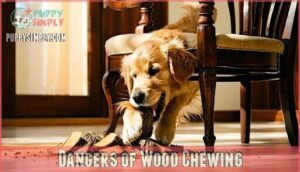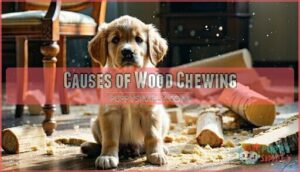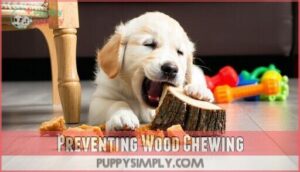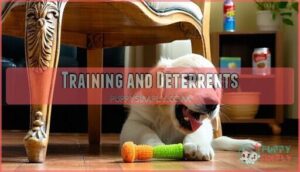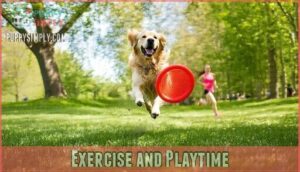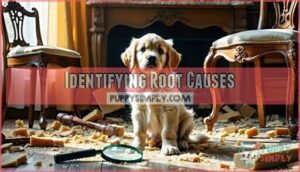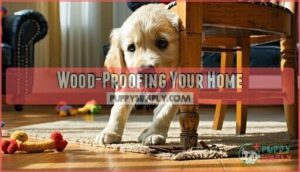This site is supported by our readers. We may earn a commission, at no cost to you, if you purchase through links.
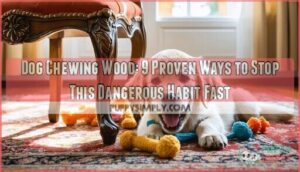 Dog chewing wood stems from natural instincts, boredom, or anxiety, but it’s dangerous—splinters can cause internal injuries and costly emergency surgeries.
Dog chewing wood stems from natural instincts, boredom, or anxiety, but it’s dangerous—splinters can cause internal injuries and costly emergency surgeries.
You’ll need to address the root cause, whether it’s insufficient exercise, separation anxiety, or simple curiosity.
Remove wood access immediately, provide appropriate chew toys, and use bitter deterrent sprays on wooden surfaces.
Consistent training with positive reinforcement works better than punishment.
If your pup’s destroying furniture or fence posts, they’re likely telling you something about their needs.
The key isn’t just stopping the behavior—it’s understanding why it started and creating better outlets for their energy.
Table Of Contents
- Key Takeaways
- Why Dogs Chew Wood
- Dangers of Wood Chewing
- Causes of Wood Chewing
- Preventing Wood Chewing
- Training and Deterrents
- Addressing Underlying Issues
- Alternative Solutions and Toys
- Monitoring and Professional Help
- Wood-Proofing Your Home
- Frequently Asked Questions (FAQs)
- How much wood chewing is normal for a puppy?
- What health issues can develop from chronic wood chewing?
- Is it okay for my dog to chew on sticks from my backyard?
- Can certain dog breeds be more prone to wood chewing?
- Are there specific wood types that attract dogs more?
- How long does it take to train away wood chewing?
- Conclusion
Key Takeaways
- Remove wood access immediately – Clear your yard of sticks and branches, secure firewood storage, and use furniture covers on wooden items since splinters can cause dangerous internal injuries that require emergency surgery.
- Address the root cause – Your dog’s wood chewing stems from boredom, anxiety, insufficient exercise, or natural instincts, so you will need to identify and fix the underlying issue rather than just stopping the behavior.
- Provide safe alternatives and training – Use bitter deterrent sprays on wooden surfaces, offer appropriate chew toys, and consistently redirect your dog with positive reinforcement when they choose proper items over wood.
- Get professional help if needed – If wood chewing persists despite your efforts, consult a veterinarian to rule out medical issues or nutritional deficiencies, and consider working with a certified behavioral trainer for anxiety management.
Why Dogs Chew Wood
Your dog’s wood-chewing habit stems from several natural and behavioral factors that you can identify and address.
Dogs chew wood due to natural instincts, boredom, anxiety, teething discomfort, or simple curiosity about different textures they encounter in their environment, which can be influenced by behavioral factors.
Natural Instincts
Dogs possess an evolutionary purpose for chewing that’s hardwired into their DNA.
This natural dog behavior serves multiple functions, from maintaining dental health to providing chewing satisfaction.
Your dog’s wood chewing stems from ancient survival instincts, regardless of breed predispositions.
Puppy development particularly emphasizes this need as they explore their world through their mouths.
- Your dog’s ancestors gnawed on bones and bark to clean their teeth naturally
- Chewing releases endorphins that create a calming, stress-relieving effect
- Different breeds have varying intensity levels for this instinctual behavior
Boredom and Anxiety
Sometimes, your pup’s wood-chomping stems from pure restlessness or stress.
Bored dog solutions include establishing exercise schedules and chew toy rotation to combat destructive dog behavior.
Identifying anxiety triggers helps you apply calming techniques like interactive games for dog anxiety relief.
When anxiety takes hold, dogs often seek outlets—unfortunately, that beautiful deck becomes their stress-relief target, and addressing this issue requires understanding the root cause of the behavior, such as destructive dog behavior, and finding appropriate solutions, including calming techniques.
Teething and Curiosity
Young puppies entering their curiosity stage naturally explore everything with their mouths, making puppy teething a prime time for destructive habits.
Inflamed gums drive them toward anything they can gnaw, including furniture and wood surfaces.
You’ll need to supervise playtime closely while offering safe chews and appropriate dog chew toys for gum relief during this vital puppy exploration phase.
Dangers of Wood Chewing
Wood chewing isn’t just a harmless habit—it can create serious health emergencies that’ll send you rushing to the vet clinic.
Your dog’s innocent gnawing can lead to dangerous splinter ingestion, painful intestinal blockages, and infections that require costly surgical intervention.
Ingesting Splinters
Sharp wood fragments turn your dog’s mouth into a minefield when they start chewing.
These razor-like splinters cause esophagus damage and intestinal perforation as they travel through your pet’s digestive system.
Splinter size doesn’t matter—even tiny pieces create infection risk requiring immediate veterinary intervention.
Dog chewing wood transforms innocent play into a medical emergency that’ll empty your wallet.
In addition, intestinal blockage can occur if large pieces are ingested, leading to a potential intestinal blockage.
Intestinal Blockages
Wood fragments can cause complete intestinal blockages, creating life-threatening emergencies requiring immediate veterinary intervention.
When your dog ingested wood pieces, obstruction symptoms include persistent vomiting, lethargy, and abdominal pain.
Diagnosis involves X-rays and physical examination to locate the blockage.
Treatment often requires emergency surgery to remove wood splinters dog consumed.
Dietary indiscretion, such as eating wood, is a primary cause of these blockages.
Prevention through supervision beats costly emergency procedures every time, and addressing dietary indiscretion is crucial for dog health, as it can lead to life-threatening emergencies and requires immediate veterinary intervention.
Infections and Veterinary Bills
Beyond blockages, wood splinters dog owners face costly infection risks when their pets chew contaminated wood. Bacteria-laden fragments create serious health concerns requiring immediate vet advice dog specialists provide.
Here’s what you’ll potentially face:
- Splinter infections requiring antibiotic treatment and wound care
- Post-surgery care involving daily medications and follow-up visits
- Bill negotiation with veterinary clinics for payment plans
- Insurance coverage claims for emergency procedures
- Preventative dentistry to address damaged teeth from wood ingestion
To prevent these issues, consider regular dental checkups for your pet.
Causes of Wood Chewing
Understanding why your dog chews wood helps you address the behavior effectively and prevent future incidents.
Several underlying factors, including separation anxiety, insufficient exercise, and attention-seeking behaviors, can drive your pet to target wooden objects in your home and yard, which is related to the dog’s need for attention-seeking behaviors.
Separation Anxiety
Some dogs develop separation anxiety when you’re away, triggering destructive behavior like wood chewing.
This emotional distress affects 14-20% of dogs and stems from attachment issues. Your dog isn’t being spiteful—they’re genuinely distressed.
Professional intervention often combines gradual desensitization with calming techniques, while severe cases may require medication options to address underlying anxiety triggers effectively.
| Anxiety Triggers | Calming Techniques | Professional Solutions |
|---|---|---|
| Owner departure cues | Long-lasting chew toys | Behavioral assessment |
| Environmental changes | Gradual desensitization | Medication options |
| Disrupted routines | Safe space creation | Training protocols |
Lack of Exercise and Training
Physical exhaustion and mental engagement serve as powerful antidotes to destructive behavior.
When you don’t provide adequate exercise and consistent training, your dog’s pent-up energy finds outlets in wood chewing. This habit often signals unmet needs rather than defiance.
- Exercise Benefits: Daily walks and play sessions reduce anxiety-driven wood chewing
- Training Consistency: Regular commands and boundaries prevent destructive habits from forming
- Mental Stimulation: Puzzle toys and brain games tire dogs mentally, reducing boredom
- Breed Needs: High-energy breeds require more intensive exercise to prevent destructive behavior
- Training Techniques: Positive reinforcement and redirect methods effectively eliminate wood chewing
Learned Behavior and Attention Seeking
Sometimes your dog’s wood-chewing isn’t just destructive behavior—it’s a calculated move for your attention.
Your dog isn’t being destructive—they’re being strategic about getting your undivided attention.
When you rush over shouting "No!" every time they gnaw furniture, you’re accidentally reinforcing the habit through negative attention. Dogs quickly learn that wood chewing guarantees a reaction, turning anxiety or boredom into learned attention-seeking behavior.
| What Your Dog Learns | Your Typical Response | Unintended Message |
|---|---|---|
| Wood chewing = instant attention | Rushing over with loud "No!" | "This behavior gets me noticed!" |
| Ignoring toys gets no reaction | Silence when playing appropriately | "Boring toys don’t work for attention" |
| Destructive behavior works best | Consistent emotional responses | "Drama equals engagement from humans" |
Positive reinforcement works better—reward calm behavior while completely ignoring the wood chewing. Break this association by making appropriate chew toys more rewarding than your frantic reactions to destructive habits.
Preventing Wood Chewing
You can stop your dog’s wood chewing habit by taking three key preventative steps that address the root of the problem.
These practical measures include removing wood access from your pet’s environment, providing safe alternative chew toys, and actively supervising your dog to redirect their attention when they approach wooden objects.
The goal is to break the habit by preventing access to wood and providing suitable alternatives.
Removing Wood Access
The first line of defense against dog chewing wood starts with woodproofing your environment.
Complete yard cleanup removes sticks, branches, and wooden debris that tempt your pup.
Secure firewood storage with tarps or covers prevents access to tempting logs.
Install furniture covers on wooden items, and consider plant protection barriers around garden beds.
Muzzle training offers temporary supervision when eating wood becomes persistent, using methods that include complete yard cleanup and secure firewood storage to prevent access to wood, and this can be a key part of muzzle training.
Providing Alternative Toys
Once you’ve cleared wood from your dog’s reach, you’ll need to fill that chewing void with safe alternatives.
Durable dog toys made from safe materials become your best friends here. Try puzzle toys that challenge your pup’s mind while satisfying their urge to gnaw.
Interactive toys keep them engaged longer than basic chew toys. Consider long lasting chewables for aggressive chewers.
Rotate options weekly to maintain interest and prevent boredom-driven wood seeking.
Supervising and Redirecting
Active supervision becomes your secret weapon when you catch your dog chewing wood.
Immediately redirect chewing behavior using consistent cues like "leave it" or "no."
Guide them toward safe alternatives like rope toys or bones.
Positive reinforcement works best—reward them when they choose appropriate chew items.
Addressing boredom can help, so provide puzzle toys to keep them entertained.
Training techniques require patience, but they’ll save you costly vet bills by using positive reinforcement.
Training and Deterrents
You can break your dog’s wood-chewing habit through consistent training methods that combine deterrent sprays, verbal corrections, and positive reinforcement.
These proven techniques work together to redirect your pet’s attention while teaching them what’s acceptable to chew and what isn’t, using consistent training methods.
Bitter-Tasting Sprays
Bitter-tasting deterrent sprays offer an immediate solution to stop dog chewing wood behavior.
Commercial options like Grannick’s Bitter Apple or homemade spray mixtures create unpleasant tastes that discourage destructive habits.
Apply these DIY sprays directly onto wooden surfaces, ensuring ingredient safety for your pet.
Many owners purchase bitter apple products for this purpose.
Reapplication necessity varies, but most sprays require weekly renewal for sustained effectiveness duration against persistent wood chewing.
Verbal Corrections and Rewards
Timing makes all the difference when using verbal cues to stop dog chewing wood behavior.
Say "no" or "leave it" immediately when you catch them in the act, then redirect to appropriate toys.
Follow up with positive reinforcement and treats when they comply.
Command consistency across all family members guarantees your dog training tips work effectively, shaping behavior through clear expectations.
This approach ensures that your dog understands what is expected of them, and consistent training leads to better outcomes.
Consistent Training and Brain Games
You’ll need Training Consistency with daily sessions to see real results.
Mental Stimulation through brain training games keeps your dog’s mind busy, reducing wood-seeking behaviors.
Puzzle Variety prevents boredom while Command Reinforcement strengthens obedience.
Consider Breed Differences when choosing training techniques—some dogs need more positive reinforcement than others.
Combine chew toys with consistent practice for maximum effectiveness.
Addressing Underlying Issues
Your dog’s wood-chewing habit might stem from medical conditions, nutritional deficiencies, or environmental stressors that require careful evaluation.
You’ll need to examine these root causes, assess your pet’s diet and living conditions, and create a secure environment to successfully eliminate this destructive behavior.
Medical Issues and Deficiencies
Some dogs develop pica behavior when facing nutrient deficiency or underlying illness affecting nutrient absorption.
Poor diet quality can trigger wood consumption as your pet seeks missing minerals like zinc or iron.
Schedule a veterinary assessment immediately if wood chewing persists, as untreated pica may lead to perforated intestines, dangerous obstruction, and devastating vet bills requiring emergency surgery.
Assessing Diet and Environment
Your dog’s wood-chewing obsession might stem from dietary deficiencies or environmental factors you haven’t considered.
A nutrient deficiency can trigger Pica, causing dogs to seek minerals from unusual sources like wood. Meanwhile, a boring environment without proper mental stimulation often leads to destructive behaviors.
Here’s how to assess both areas:
- Review your dog’s current diet – Check if you’re feeding a complete, balanced food that meets AAFCO standards
- Consider switching to a raw diet – Some dogs benefit from fresh, whole foods that provide better nutrient absorption
- Evaluate your home’s environmental enrichment – Count how many safe chewables and puzzle toys are available daily
- Examine your dog’s exercise routine – Insufficient physical activity often manifests as wood chewing behaviors
- Assess mental stimulation opportunities – Dogs need brain games and challenges to prevent boredom-driven destruction
Creating a Safe Space
Anxiety-ridden dogs need a secure den where they feel protected from overwhelming situations.
Create this safe space using comfort items like familiar blankets, calming music, and positive reinforcement techniques.
This environmental enrichment serves as alternative solutions for separation anxiety, helping your dog retreat when stressed rather than turning to destructive wood chewing behaviors.
It’s also wise to prepare pet safe evacuation bags with familiar items.
Alternative Solutions and Toys
You can redirect your dog’s destructive wood-chewing habit by providing engaging alternatives that satisfy their natural need to chew and explore.
Interactive puzzle toys, regular exercise routines, and mentally stimulating games will channel your pet’s energy into positive behaviors.
While keeping their mind occupied and reducing boredom-driven destruction is key, providing these alternatives is crucial for redirecting your dog’s energy into positive behaviors, utilizing interactive games to satisfy their needs.
Puzzles and Games
Boredom becomes the enemy when your dog’s mind lacks stimulation.
Interactive toys and puzzles provide cognitive benefits that tire mental muscles as effectively as physical exercise.
Start with beginner puzzle difficulty, then advance gradually.
Treat dispensing games keep dogs engaged for hours.
Many owners find success with interactive treat puzzles.
Establish a rotation schedule with various chew toys and interactive puzzles for ideal environmental enrichment.
Exercise and Playtime
Physical activity works wonders when your dog’s chomping on wood becomes a daily headache.
Exercise benefits include reducing destructive behaviors, while consistent playtime frequency prevents boredom-driven chewing. Consider your dog’s breed energy levels when planning an activity routine.
Here’s your action plan:
- Morning walks – 30-45 minutes before work
- Afternoon play sessions – fetch or tug-of-war games
- Evening activities – jogging or yard exploration
Mental Stimulation and Channeling Energy
Your dog’s restless energy needs an outlet beyond basic walks.
Puzzle toys and interactive games provide mental stimulation that tires minds faster than physical exercise alone. Rotate training techniques weekly, incorporating food-dispensing puzzles during your playtime routine.
When dogs engage their brains solving problems, they’re less likely to seek entertainment through destructive dog chewing wood behaviors, which can be mitigated by using puzzle toys and providing adequate mental stimulation.
Monitoring and Professional Help
Sometimes you’ll need to step back and get professional guidance to tackle your dog’s wood-chewing habit effectively.
A veterinarian can identify underlying health issues that might be driving this behavior, while pet cameras help you monitor what happens when you’re not around to redirect the chewing in real-time.
Identifying Root Causes
Getting to the bottom of your dog’s wood chewing problem requires detective work.
Look for behavioral triggers like separation anxiety or boredom that spark destructive behavior.
Consider medical evaluation to rule out nutritional deficiencies or health issues.
Environmental stressors, dietary factors, and anxiety indicators all play roles, and understanding these root causes helps you tackle the habit effectively.
Veterinary Consultation and Behavioral Training
When your dog’s wood-chewing habit persists despite your best efforts, professional help can turn the tide.
A veterinarian’s medical evaluation rules out underlying health issues, while certified behavior training addresses destructive behavior patterns through proven anxiety management techniques.
Professional intervention typically includes:
- Comprehensive diet assessment to identify nutritional deficiencies driving compulsive chewing
- Customized training techniques targeting your dog’s specific triggers and motivations
- Structured anxiety management protocols combining environmental modifications with behavioral conditioning
Pet Cameras and Vocal Commands
Modern pet cameras offer remote monitoring solutions for dog chewing wood behaviors when you’re away.
These devices enable real-time behavior intervention through vocal commands, helping reduce anxiety-driven chewing episodes.
You’ll capture valuable data about your dog’s chewing patterns while maintaining command effectiveness.
However, consider data privacy settings when selecting camera systems, as some models store footage on external servers rather than local devices.
Wood-Proofing Your Home
You can’t always watch your dog, but you can control what’s available for them to chew by making strategic changes to your home environment.
By removing accessible wood sources and applying protective measures to unavoidable wooden surfaces, you’ll create a safer space that reduces temptation and prevents dangerous chewing incidents.
Clearing The Yard
A clean sweep of your yard removes tempting wood targets that fuel your dog’s destructive habit.
Start by eliminating all accessible wood pieces, from fallen branches to decorative logs that could become splinter-filled snacks.
- Remove all sticks, branches, and fallen logs from accessible areas
- Replace wood mulch with safe alternatives like rubber or gravel ground cover
- Install safe plants that won’t attract wood chewing behavior to prevent damage and ensure a safe environment for your dog, promoting a clean yard.
Securing Wood Surfaces
After clearing your yard, focus on protecting indoor wooden furniture and surfaces.
Cover valuable pieces with furniture covers or apply wood sealants to create surface barriers.
Install creative solutions like corner guards on wooden furniture legs.
Apply deterrent spray to high-risk areas where your dog typically targets.
Consider using pet barriers to block access to rooms with vulnerable wood.
These chewproof furniture strategies prevent costly damage while you’re training your pet to use deterrent spray.
Using Deterrent Sprays and Sealants
Since bitter-tasting deterrent spray creates an unpleasant experience your dog won’t repeat, applying these solutions transforms wooden furniture into off-limits territory.
Homemade spray mixtures using safe ingredients offer budget-friendly alternatives to commercial deterrents, while proper application techniques guarantee lasting protection against your pet’s persistent chewing habit.
- Create DIY deterrents using white vinegar mixed with water at a 1:5 ratio for natural protection
- Test application techniques on small furniture areas first to prevent surface damage from sealants
- Monitor reapplication frequency weekly or after cleaning to maintain spray effectiveness consistently
- Choose pet-safe options avoiding sealant toxicity by selecting non-toxic, natural ingredient formulations
Frequently Asked Questions (FAQs)
How much wood chewing is normal for a puppy?
Puppy wood chewing isn’t normal behavior you should accept.
While teething drives exploration, wood poses serious health risks including splinters and blockages.
Redirect this behavior immediately with appropriate chew toys and training.
What health issues can develop from chronic wood chewing?
Chronic wood chewing can cause serious digestive blockages, mouth injuries from splinters, bacterial infections, and dental damage. You’ll face expensive vet bills if splinters perforate your dog’s intestines or throat.
Is it okay for my dog to chew on sticks from my backyard?
Imagine this: your pup happily gnawing on that fallen branch while danger lurks beneath the bark.
No, backyard sticks aren’t safe—they can splinter, cause blockages, and harbor bacteria that’ll send you straight to the vet.
Can certain dog breeds be more prone to wood chewing?
Certain breeds aren’t specifically predisposed to wood chewing, but high-energy working breeds like German Shepherds, Labs, and Border Collies may develop this habit more frequently.
Due to their need for mental stimulation and exercise, these breeds may exhibit wood chewing behavior as a result of their inherent characteristics and requirements.
Are there specific wood types that attract dogs more?
Like a magnet draws metal, certain woods naturally attract your dog’s attention.
Softwoods like pine and cedar appeal most due to their texture and scent, while treated lumber poses greater health risks than natural varieties.
How long does it take to train away wood chewing?
Training duration varies substantially based on your dog’s age, consistency, and the behavior’s severity.
Most dogs show improvement within 2-4 weeks of consistent training, but complete elimination may take 2-3 months with dedication.
Conclusion
Ironically, your dog’s destructive wood chewing habit can become your strongest bonding opportunity.
By understanding the root causes and implementing these proven strategies, you’ll transform this dangerous behavior into a chance for better communication with your pet.
Remember, stopping dog chewing wood requires patience, consistency, and addressing underlying needs rather than just the symptoms.
Your furry friend isn’t being defiant—they’re simply expressing unmet needs that you can now confidently address with the right approach.
- https://www.honestpaws.com/blogs/health/dog-digestive-anatomy-intestinal-blockage
- https://www.medvet.com/gastrointestinal-foreign-bodies/
- https://www.vetandtech.com/blogs/dog-intestinal-blockage-timeline
- https://pawpits.com/dog-intestinal-blockage-timeline-warning-signs/
- https://feelgoodhhs.com/can-dogs-digest-wood-understanding-the-risks-and-symptoms/

